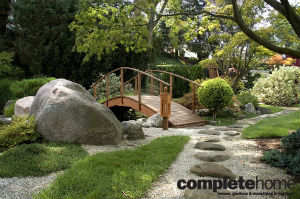
Story: Elizabeth Re
Gone are the days when cacti and succulents were thought of only as desert-dwelling plants. With drought, climate change and water conservation being hot topics, succulents, with their ability to withstand dry conditions, have become the trendy trademarks of a modern, eco-friendly garden.
The word succulent means juicy or fleshy and, thanks to their incredible water storage abilities, that’s exactly what these plants are. Although all plants store water, by definition, a succulent is any plant that stores more water than it uses on that day. Most commonly, the leaf of a succulent is its water storage centre and where it converts the sun’s energy into food. You can also find succulents that have this same nutrient-storage material in their roots or stems.
Although cacti are classified as a succulent plant, there is a difference between cacti and succulents. Instead of fleshy leaves, cacti tend to have spikes on their surface, which reduce wind speed and thus water loss.
One person who knows succulents intimately is David Kirkpatrick from landscape design company Outdoor Creations. David, who has featured on Channel Ten’s 9am with David and Kim, has had to change his designs with the changing climate and says succulents are a great way to create a drought-proof garden.
“We encourage our clients to select drought-resistant plants such as succulents and natives and install water tanks as water-saving measures,” he says. “With our changing weather patterns we need to be proactive and select species that are built for survival.”
With their exotic looks and striking colours — and some with beautiful flowers — succulents are gaining attention for more than just their water-saving properties. David has unearthed the visual potential of using succulents in landscape design.
“They are a fabulous architectural feature point, whether in a tub, on the verandah or in your garden,” he says.
Planting your succulents
There is a huge variety of succulent plants to choose from, all with a diverse range of leaf shapes and colours. Their evergreen foliage and exotic looks make them ideal for urban gardens.
Their versatility means they will flourish either in a pot on decking or integrated into the garden. Most species of succulents can be planted in pots or containers as the restriction of their roots stunts their growth and keeps them contained.
As most succulents are shallow rooted, it’s best to plant them in wide, shallow pots. If you put a shallow rooted succulent in a deep pot, the soil below the roots tends to stay wet for prolonged periods after watering and can cause rot.
Choosing the right soil type is also important when planting succulents because they like well-drained soil. If planting in a tub, David’s tip is to use ordinary potting mix and combine it with sand and gravel.
“If planting directly into the soil make sure it is near a drainage line or in well-drained soil to ensure maximum growth,” he advises.
Caring for succulents
Succulents are ideal plants for busy people who want a low-maintenance garden, or anyone wanting to dress up a small courtyard or balcony. David says succulents will thrive in harsh conditions as long as you maintain two basic principles: plenty of light and no over-watering.
“If succulents are over-watered they will turn brown,” he warns. And if under-watered, he says, they tend to become wrinkled and the wrinkles will remain permanently. A good guide is to water them once a week in summer and about once a month in winter, depending on rainfall.
Succulents like sun and plenty of it. David says if they are left in the shade for too long they can develop rot, lose their colour and become prone to mealy bug.
“Put them in a north or west-facing window on the verandah or in the garden, but take care that they are not obscured by other plants. They will survive on an east side but will need to be put in direct sunlight now and then,” he says.
Succulents are tough little plants and like to be treated that way. It’s important not to fertilise them too much as they will lose their colour. Give them a little slow-release fertiliser every now and again, though.
There are more than 50 families of succulents and hundreds of different types. The diversity in colour, shape and size of succulents make them a modern and dramatic addition to any backyard. And with their incredible water-saving properties, they are set to become much more than just a gardening trend. Succulents are here to stay.
David’s top picks
• Aloe vera: “It is hardy, attractive and when you get drunk and fall on the barbecue it can help heal the burns!” Aloe vera can be planted in full sun in the garden or grown in pots or tubs.
• The Echinopsis group: “For their often large and brilliantly coloured flowers.” This group of succulents comes in many different shapes and sizes. They can be small and round, large and barrel-like or columnar. They are one of the easiest species of succulents to grow and can thrive indoors or out.
• The Pachyveria species: “They are cute and divide easily and you can use them as a base for larger plantings.” Pachyveria are rosette-forming succulents often used as ground cover in the garden. In pots they look fabulous crammed in together and spilling over the edges.





